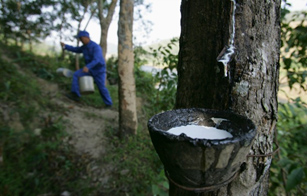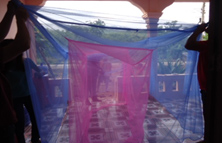Lao PDR
Relationship between rubber plantation development, variation of mosquito population and its consequence on public health
Background and rationale

Laos is experiencing a period of unprecedented exchange in land use, particularly the deforestation of wide areas of primary and secondary rain forest for rubber plantations. Its impact on vector-borne disease dynamics is still poorly understood. However, It may have a profound impact on disease risk, particularly if the mono culture forests provide an environment all which favors vector species development. Both malaria and dengue are endemic vector-borne diseases in Lao PDR, while Chikungunya is suspected to-have spread from neighboring countries. This change in dynamics has potentially important public health consequences

The Lao natural forest is a mixture of primary and secondary growths. The primary forest corresponds to 9.2% (1,490,000 ha), Whereas secondary forest makes up 60.8%. The area of rubber plantations around 6,900 ha was estimated goal in 2011 is to reach 28,800 ha planned in 2014 and 147,500 ha in 2015. After 2015 the area of rubber plantations will continues to grow with 342.400 currently ha of land designated for rubber plantations (NAFRI , 2011). |
 |
|
|
 |

Seasonal workers at the plantations could create a whole new dynamic for the vector-borne diseases. Currently 37,500 people work on rubber plantations. In the coming decade, it is expected to create work for reviews another 177.700 people. This will increase the need for seasonal workers from other areas. These temporary workers-have immunity against may not the local diseases. Additionally thesis workers can spread diseases by transporting em to and from Lao rubber plantation areas. Even more worrying is the possibility of a drug resistant strain Introducing, like ACT resistance. |
Objectives and Strategy of Intervention

The primary objective is to Assess the relationship between rubber plantations on large areas, development / change of mosquito population, and Its consequences on vector-borne disease dynamics and risks.
|
The Specific objectives are to: |
|
|
Determine whether determined to vector mosquito diversity / abundance, and prevalence of malaria / dengue / positive vectors Differ in oven habitats chikungunya: 1) immature rubber plantation, 2) mature rubber plantations, 3) secondary rain forest and 4) the village |
|
|
Compare and correlate different mosquito collection methods to understand how efficient and reliable the different methods are (without using exposed humans), surveying for the mosquito ecology in an area; |
 |
|
|
Provide data on two aspects of interest for future vector control: identification of mosquito breeding site in the rubber plantations; and detection of mosquito resistance to be commonly used insecticides; |
|
|
Better understand the vector ecology in rubber plantations to minimize vector-borne disease incidence in the current circumstances and in the future with the changing dynamics |
|
|
Release public health recommendations for protecting forest workers and neighboring vector populations against terminal diseases risk. |

To make this point the project Will undertake a 3-year field study
|
♦ Study Sites |
|
The 3 locations are located in. the north of Laos, in Luang Prabang province, Lao owned in small scale rubber plantations. Each study area consists of stands of mature and immature rubber plantations, secondary forest, and neighboring villages. Basic laboratory and amenities are, established in the area. |
|
|
A strong component consists in entomology collection of adult mosquitos on the different study sites in the study of aquatic habitats used by the mosquito larvae for their development into adults to better know the distribution of the different species of mosquito vectors accordingto the different environmental requirements. |
|
|
The identification and evidence for vector-borne disease presence (malaria, dengue, chikungunya and) collected within the adult mosquitos is performed live by PCR diagnostic tests in Laos IP. |
|
|
The burden of vector-borne disease and mosquito density on the population is evaluated by Participatory Rural Appraisal combined with survey of district and provincial data on dengue, chikungunya and malaria incidence. |
|
|
The assessment of innovative broadly accepted and vector monitoring methods in local terms will help to better standardize studies of mosquito population in similar environment. |
|
|
Detecting resistance status to insecticides for vector control utilized using a WHO standard method will result in practical recommendations for insecticides selection |
Expected results
At the end of the project:

The analysis will have provided an assessment of the potential risk related to vector-borne disease infections arising in rubber plantations

Documented evidence for reliable and safe techniques to trap mosquitoes will have been provided to entomologists working environment in SEA

According to this assessment, public health recommendations for the protection of forest workers will be issued and communicated to national authorities and under plantation management.
Beneficiaries of project ECOMORE

Workers / tappers of the rubber tree plantation in Lao PDR; determination of peak activity of different mosquitoes, characterizing, resistance to insecticides and identifying of preferential breeding site will result in practical recommendations to minimize the risk of vector terminal diseases in the plantations

Owners of rubber tree plantations in Lao PDR; proficient tappers are key people to run the business while producing latex decreasing the incidence of disease will Be beneficial for the use

Villagers living around the plantations will Be aware of the preferential breeding site in each environment can simply manage and reduction of vector density in their village;

Entomologists in Southeast Asia will get critical data on the efficiency of safe trapping methods (vs. HLC);

MoH in Lao PDR Will get documented information to help estimate the cost of frenzied development of rubber tree plantations and movement of workers, that 'influences policy makers
ACTIVITIES
Implementing Team


